If you have a Cluster Fly problem in your home you will know about it. Cluster flies are very easy to spot and distinguish from other flies.
Before we explain how to deal with them, let’s fist cover what they are and how their life cycle works, as by knowing this you’ll have a much better chance of stopping them returning.
What Are Cluster Flies?
Cluster Flies are a group of flies which as the name suggests cluster at certain times of year.
They are different from the most common other flies you will see in your home, the Common House Fly and the Blue Bottle, and do not pose the same health risks, thankfully.
They are a nuisance, especially in the large numbers they can sometimes get to.
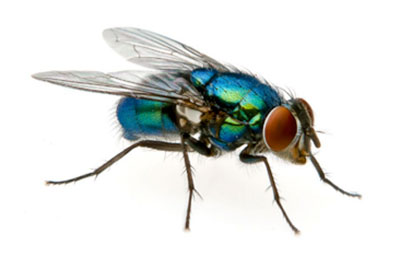
Blue bottle fly – Image courtesy of Pinterest
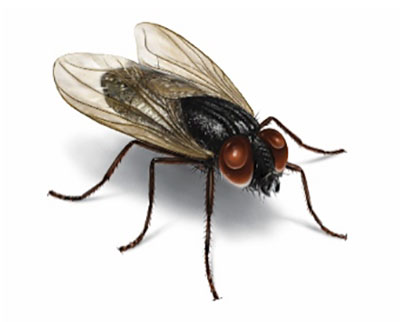
Common house fly – Image courtesy of Orkin
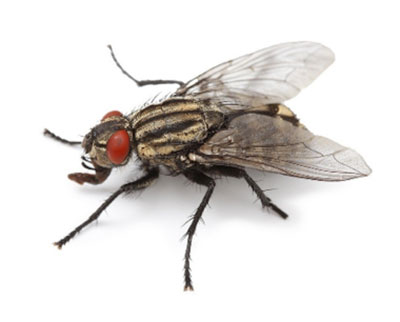
Cluster fly – Image courtesy of Bugspray.com
There are 4 different types of Cluster Fly that you might see:
- Autumn Fly (Musca autumalis)
- Common Cluster Fly (Pollenia rudis)
- Green Cluster Fly (Dasyhora caynella)
- Yellow Swarming Fly (Thaumatomya notata)
While each is a little different, but you can easily distinguish them, as a group, from the much larger Blue Bottle and more “manic” House Fly, as they are all lazy, slow fliers and will congregate in large numbers if allowed. The slow flying does making them easier to swat!
Breaking the Cluster Fly Life Cycle
The key to getting rid of cluster flies is to understand their life cycle and break it.
In the summer cluster flies live and breed in fields and open spaces. The female lays her eggs in the soil where they will hatch after a couple of days.
The larvae are parasitic on earthworms, in which they live and feed for around 3 weeks before pupating.
The adult fly will emerge from the pupea after a further 2 weeks, to begin feeding on flowers and nectar.
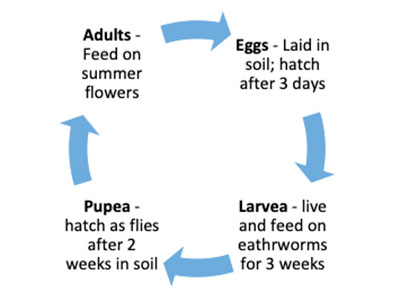
The Life Cycle of the Cluster Fly – Summer
Over the summer this cycle will continue until autumn comes and the evenings get colder, making the adult cluster fly want to find a suitable warm and dry place to hibernate.
They congregate in warm walls or trees, usually south facing, in the sun to look for a crack or crevice to spend the winter.
With hundreds and thousands of flies all looking for a warm winter spot they will tend to cluster, giving them their name.
A house, particularly near open fields where they will have spent the summer, will be very attractive to cluster flies.
They will try to find any warm, dry crack or crevice which would mimic their natural hibernation spots such as cracks in bark or hollow trees.
In the autumn you will see cluster flies trying to get in through cracks and vents, but lofts are particularly inviting and impossible to stop them getting into.
Again in spring when the weather begins to warm up again they will fly from their winter hibernation spot to find other adults to mate with.
When they wake from their hibernation they are attracted to light, guiding them back to the fields and potential mates.
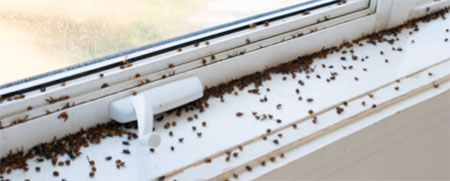
Cluster Flies around a window – Image courtesy of Vermatech Pest Control
It is believed that the flies leave a pheromone or scent which future generations can use to find a suitable location to hibernate the following year.
This means that if you start to get cluster flies hibernating in your house or loft it is highly likely that more will appear the following year if they are not stopped.
Health Issues with Cluster Flies
The good news about cluster flies, unlike the other types of flies you see in your home, the Blue Bottle and the House Fly, is that they do not feed on food waste or excrement so are considerably less harmful.
They will transfer germs from anything they land on, but they will not actively seek unhygienic surfaces.
Cluster Flies are not a sign of poor hygiene.
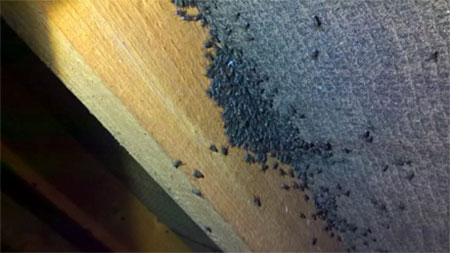
Cluster Flies Love Loft Spaces – Image courtesy of Kestrel Pest Control
In small numbers they are simply a nuisance but unchecked they can get into considerable numbers.
They will excrete and die, leaving carpets of dead flies across an unchecked loft space, for instance.
They are hard to clear up and might attract other creatures to feed on their little carcasses.
The earlier that you can deal with the problem the less on an issue it is likely to be.
Stopping Cluster Flies – Stop the Autumn Invasion
For whatever reason, whether it is pheromones, scent or some inherited memory, cluster flies will return year after year, in greater number if unchecked. Stop this and you will not have a problem, however this is easier said than done.
Once the flies have settled into their roosts which will be cracks and crevices, even in your loft space, there is really nothing that can be done before they wake again in the spring, so the spring and autumn particularly when they are active are the times to deal with them.
It is impossible to stop them entering your home with screens as they are very clever and seeking our any crack and getting in. Protecting a loft space like this while maintaining the necessary air flow is not feasible.
That said it is worth closing trickle vents or other entry points flies might be using if you can. Repoint gaps and joints and seal any gaps especially around windows and doors.
How to Cure a Cluster Fly Infestation
Stopping Cluster Flies returning is definitely something that can be done yourself with a little determination, particularly if the infestation is not too big.
As we have seen it is very hard to stop the flies getting in, so while you should seal cracks and gaps, don’t expect this to be the cure.
In North America they recommend screens over windows and spray chemicals on external entry points such as cracks and the eaves.
Hopefully you will not need extreme measures like these, but if you do, use a specialist insect spray designed for crawling insects. Spray it on anywhere the flies will have to crawl through the gaps to get in, inside and out.
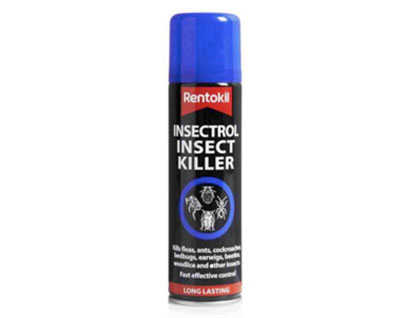
Spray likely Cluster Fly entrance points with a Crawling Insect Killer Aerosol
This is our 3 step process for getting rid of cluster flies and stopping them returning:
- Seal entry points where practical
- Spray flies – regularly when seen in autumn and spring
- Hoover up flies and clean any fly excrement
Repeat regularly – daily if necessary – whenever flies are flying. This will reduced the number that successfully hibernate and also those that get away in spring to breed, leaving whatever scent or pheromone they leave, thereby not attracting back their offspring in autumn.
Clambering into the loft regularly to spray throughout the late summer to autumn and then again in spring will work eventually.
If there is a mild spell in winter, check the loft as some flies might think that spring has come early and wake. Give them a good spray to put them back into permanent hibernation!
What Kills Cluster Flies
If you use any form of insecticide you should confirm there is no evidence of bats. If there is any possibility that it might come into contact with bats, it is illegal to use insecticide.
Here’s our list of Cluster Fly Killing tools you need to eradicate any infestation:
Fly Spray
Use any normal “knock down” fly spray. It will be very effective on all active flies, but not so on flies already hibernating; if you’ve missed them, you’ll have to wait until spring to get these once they are active again.
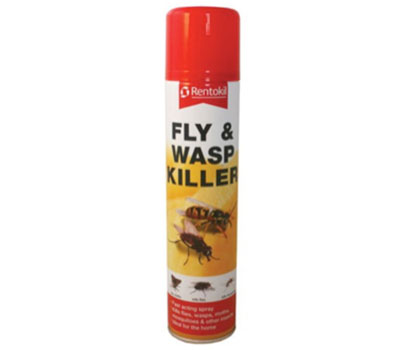
Any “Knock Down” Fly Spray will Kill Cluster Flies
Timer Sprayer
To save the effort of continually clambering up into the loft there are automatic fly spray dispensers, which will periodically give a squirt of insecticide.
These are specifically designed for dealing with cluster flies and you will need to get sufficient for the size of your loft space.
You can get them from specialist pest control retailers who will be able to advice on sizes and amounts of sprayers.
To be safe a battery powered version should be used in loft spaces.
Power Foggers or Insecticide Bombs
If you have a particularly large infestation, and you do not need to use the room or loft space for a while, you can use an insecticide bomb give a through release of chemical for a one off “kill”. This will kill large numbers in one go, but will almost certainly need repeat treatments.
Care is needed if these are to be used in a loft space as they will burn for around 10 minutes, causing a potential fire risk. You might need several depending on the size of the space.
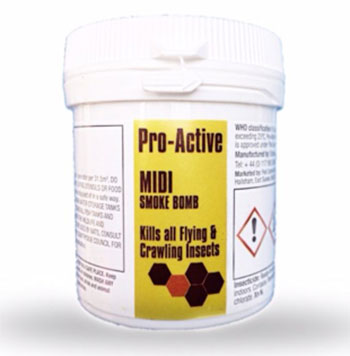
Pro-Active midi smoke fumer generator
Fly Box or Electric Light Killer
These are very effective, but more expensive to buy and fit. You will typically see versions of these in commercial kitchens. Make sure that if you plan to use one in the loft you have one that is safe to do so as they can be a fire hazard.
The benefit of these is that they will continue working all the time and also they collect the dead flies in the box saving another nasty job.
Fly Paper or Window Stickers
These are usually designed for house flies who have different feeding habits to cluster flies so are not usually seen as a solution, but they can be very helpful in catching stragglers once you have sprayed the bulk of the infestation.
In summary, Cluster Flies are not really harmful nor an indication of poor hygiene. They are unpleasant and a nuisance particularly in large numbers.
Getting rid of them is definitely possible yourself with some fly spray and determination. The key to stopping Cluster Flies returning is break their cycle so that they find a better place than your home to hibernate over winter.

